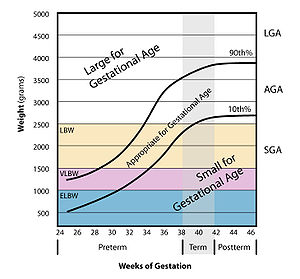Small for gestational age
| Small for gestational age | |
|---|---|
 |
|
| Graph showing which babies fit the definition of small. (DiseaseDB #31952) | |
| Classification and external resources | |
| Specialty | pediatrics |
| ICD-10 | P05, P07 |
| ICD-9-CM | 764, 765 |
| MeSH | D007230 |
Small for gestational age (SGA) newborns are those who are smaller in size than normal for the gestational age, most commonly defined as a weight below the 10th percentile for the gestational age.
Not all newborns that are SGA are pathologically growth restricted and, in fact, may be constitutionally small. If small for gestational age babies have been the subject of intrauterine growth restriction (IUGR), formerly known as intrauterine growth retardation, the term SGA associated with IUGR is used. Intrauterine growth restriction (IUGR) refers to a condition in which a fetus is unable to achieve its genetically determined potential size. This functional definition seeks to identify a population of fetuses at risk for modifiable but otherwise poor outcomes. This definition intentionally excludes fetuses that are small for gestational age (SGA) but are not pathologically small. Infants born SGA with severe short stature (or severe SGA) are defined as having a length less than 2.5 standard deviation scores below the mean.
A related term is low birth weight (LBW), defined as an infant with a birth weight (that is, mass at the time of birth) of less than 2500 g (5 lb 8 oz), regardless of gestational age at the time of birth. Related definitions include very low birth weight (VLBW) which is less than 1500 g, and extremely low birth weight (ELBW) which is less than 1000 g. Normal Weight at term delivery is 2500 g - 4200 g.
SGA is not a synonym of LBW, VLBW or ELBW. Example: 35 week gestational age delivery, 2250g weight is appropriate for gestational age but is still LBW. One third of low-birth-weight neonates - infants weighing less than 2500g - are small for gestational age.
There is an 8.1% incidence of low birth weight in developed countries, and 6–30% in developing countries. Much of this can be attributed to the health of the mother during pregnancy. One third of babies born with a low birth weight are also small for gestational age. Infants that are born at low birth weights are at risk of developing neonatal infection.
Both low and high maternal serum Vitamin D (25-OH) are associated with higher incidence SGA in white women, although the correlation does not seem to hold for African American women.
The condition is determined by birth weight and/or length.
...
Wikipedia
